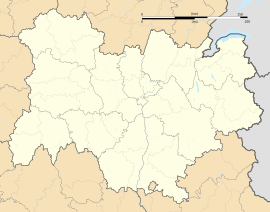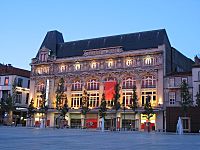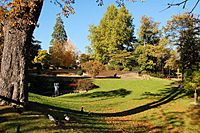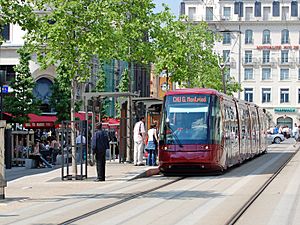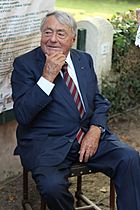Clermont-Ferrand facts for kids
Quick facts for kids
Clermont-Ferrand
Clarmont-Ferrand (Occitan)
|
|||
|---|---|---|---|
|
Prefecture and commune
|
|||
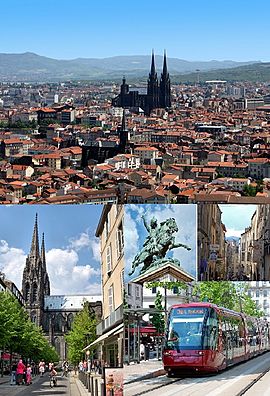
Photomontage: view of the historic center from Montjuzet Park (top)
Victoire Square and Notre-Dame-de-l'Assomption Cathedral; Statue of Vercingétorix; and Chaussetiers Street (middle) Basilica of Notre-Dame du Port (bottom) |
|||
|
|||
| Country | France | ||
| Region | Auvergne-Rhône-Alpes | ||
| Department | Puy-de-Dôme | ||
| Arrondissement | Clermont-Ferrand | ||
| Canton | 6 cantons | ||
| Intercommunality | Clermont Auvergne Métropole | ||
| Area
1
|
42.67 km2 (16.47 sq mi) | ||
| • Urban
(2018)
|
181 km2 (70 sq mi) | ||
| • Metro
(2018)
|
2,845 km2 (1,098 sq mi) | ||
| Population
(2021)
|
147,327 | ||
| • Density | 3,452.7/km2 (8,942.5/sq mi) | ||
| • Urban
(2018)
|
272,551 | ||
| • Urban density | 1,506/km2 (3,900/sq mi) | ||
| • Metro
(2018)
|
504,157 | ||
| • Metro density | 177.208/km2 (458.97/sq mi) | ||
| Time zone | UTC+01:00 (CET) | ||
| • Summer (DST) | UTC+02:00 (CEST) | ||
| INSEE/Postal code |
63113 /63000-63100
|
||
| Elevation | 321–602 m (1,053–1,975 ft) (avg. 358 m or 1,175 ft) |
||
| 1 French Land Register data, which excludes lakes, ponds, glaciers > 1 km2 (0.386 sq mi or 247 acres) and river estuaries. | |||
Clermont-Ferrand is a city in France, located in the Auvergne-Rhône-Alpes region. It is home to about 147,000 people. The larger area around the city has over 500,000 residents. Clermont-Ferrand is the capital city of the Puy-de-Dôme area. The current mayor is Olivier Bianchi.
The city is in a flat area called Limagne, surrounded by mountains. It is famous for the chain of volcanoes nearby, called the Chaîne des Puys. One of these is the sleeping volcano Puy de Dôme, which is 10 kilometers (6 miles) away. You can see its communication towers from the city. In 2018, this volcanic area was added to the UNESCO World Heritage List.
Clermont-Ferrand is one of France's oldest cities. The Greeks knew it as the capital of the Arverni tribe. Later, it became a Roman city called Augustonemetum. The main Roman area was where the cathedral stands today. Over time, the city faced attacks from different groups like the Vikings.
In 1095, an important meeting called the Council of Clermont happened here. During this meeting, Pope Urban II called for the First Crusade. In 1551, Clermont became a royal town. In 1610, it officially became a part of the French Crown.
Today, Clermont-Ferrand hosts the Clermont-Ferrand International Short Film Festival. This is one of the world's biggest festivals for short films. The city is also where Michelin, the famous tire company, has its main office. Michelin started here over 100 years ago. Many students live in Clermont-Ferrand, making it a lively place for learning. It was the first city in France to join the UNESCO Learning City Network.
The city has a unique Gothic style Cathedral made of black lava stone. Another famous spot is Place de Jaude, a large public square. Here, you can see a big statue of Vercingetorix on a horse. He was a Gaulish leader who fought the Romans. The statue was made by Frédéric Auguste Bartholdi, who also created the Statue of Liberty.
Contents
History of Clermont-Ferrand
How Clermont-Ferrand Got Its Name
Clermont-Ferrand was first called Augustonemetum. This Latin name means "sacred place for Augustus". It was also known as Civitas Arvernorum, meaning "town of the Arverni people". The city started on a hill where the cathedral is now.
In 848, a strong castle called Clarus Mons gave its name to the whole town. Later, in 1731, a smaller town called Montferrand joined with Clermont. Together, they became Clermont-Ferrand. This joining was made official by French kings. The older part of Clermont is still marked by where its old walls used to be.
Ancient Times and Roman Era
Clermont is one of France's oldest cities. The Greek geographer Strabo first wrote about it. He called it the "capital of the Arverni" people. At that time, the city was called Nemessos, a Gaulish word for a sacred forest. It was located on the hill where Clermont-Ferrand Cathedral stands today.
Near Nemessos, a famous Gaulish leader named Vercingetorix was born around 72 BC. He later led the Gauls against the Roman invasion by Julius Caesar. Nemessos was close to the plateau of Gergovia. Here, Vercingetorix won a battle against the Romans in 52 BC. After the Romans took over, the city became Augustonemetum. This name combined its old Gaulish name with the Roman Emperor Augustus.
Early Middle Ages
The city became a bishop's home in the 5th century. Bishop Namatius built a cathedral here. Clermont faced tough times after the Roman Empire ended. It was attacked by groups like the Visigoths and Franks. From 471 to 475, the Auvergne area was often attacked by the Visigoths. The city was often under siege.
In 475, the city was given to the Visigoths. It stayed part of their kingdom until 507. Then, it became part of the Kingdom of the Franks. In 535, the first Council of Clermont took place. Bishops from different areas attended this important meeting.
In 570, Bishop Avitus told the Jewish people in the city to become Christian or leave.
In 848, the city was renamed Clairmont after a castle. During this time, the bishop ruled the city. Clermont was also attacked by the Vikings in 862, 864, and 898. Bishop Étienne II built a new Romanesque cathedral. This cathedral was finished in 946. Most of it was later replaced by the current Gothic cathedral.
Middle Ages
Clermont was the starting point for the First Crusade. This was when Christians tried to take back Jerusalem from Muslim rule. Pope Urban II called for this crusade in 1095 at the Second Council of Clermont.
In 1120, there were problems between the counts of Auvergne and the bishops of Clermont. To balance the power, the counts built a new city called Montferrand. It was next to Clermont. For a long time, Clermont and Montferrand were separate cities. Clermont was ruled by its bishop, and Montferrand by its count.
Modern Times
Clermont became a royal city in 1551. In 1610, it officially became part of the French Crown. On April 15, 1630, the two cities, Clermont and Montferrand, were joined together. This union was confirmed again in 1731 by King Louis XV. At this point, Montferrand was much smaller than Clermont.
Montferrand tried three times to become independent again. This happened in 1789, 1848, and 1863. In the 20th century, the building of Michelin factories and new city gardens helped to truly unite the two cities. Even today, they still have two different downtown areas. Montferrand also keeps its own strong identity.
Geography and Climate
Clermont-Ferrand's Climate
Clermont-Ferrand has an oceanic climate. The city is in a "rain shadow" because of the Chaîne des Puys mountains. This means it gets very little rain, making it one of the driest places in France. The mountains also block the ocean's influence. This gives the city colder winters and hotter summers compared to other nearby cities.
From November to March, it often freezes. The city is in a valley, so it can have "temperature inversions." This is when the mountains are sunny and warm, but the city below is cold and cloudy. Snow is common but usually light and doesn't last long. Summer temperatures often go above 35°C (95°F). Sometimes, there are strong thunderstorms. The hottest temperature ever recorded was 40.9°C (105.6°F) in 2019. The coldest was -29.0°C (-20.2°F).
| Climate data for Clermont-Ferrand, elevation: 331 m (1,086 ft), 1981–2010 normals, extremes 1923–present | |||||||||||||
|---|---|---|---|---|---|---|---|---|---|---|---|---|---|
| Month | Jan | Feb | Mar | Apr | May | Jun | Jul | Aug | Sep | Oct | Nov | Dec | Year |
| Record high °C (°F) | 22.1 (71.8) |
25.9 (78.6) |
26.6 (79.9) |
31.3 (88.3) |
33.0 (91.4) |
40.9 (105.6) |
40.7 (105.3) |
39.6 (103.3) |
36.8 (98.2) |
29.7 (85.5) |
24.7 (76.5) |
21.9 (71.4) |
40.9 (105.6) |
| Mean daily maximum °C (°F) | 7.6 (45.7) |
9.2 (48.6) |
13.1 (55.6) |
15.7 (60.3) |
19.9 (67.8) |
23.4 (74.1) |
26.5 (79.7) |
26.1 (79.0) |
22.3 (72.1) |
17.6 (63.7) |
11.3 (52.3) |
8.0 (46.4) |
16.8 (62.2) |
| Daily mean °C (°F) | 3.7 (38.7) |
4.8 (40.6) |
7.9 (46.2) |
10.2 (50.4) |
14.3 (57.7) |
17.6 (63.7) |
20.3 (68.5) |
19.9 (67.8) |
16.5 (61.7) |
12.8 (55.0) |
7.3 (45.1) |
4.4 (39.9) |
11.7 (53.1) |
| Mean daily minimum °C (°F) | −0.1 (31.8) |
0.3 (32.5) |
2.7 (36.9) |
4.7 (40.5) |
8.7 (47.7) |
11.9 (53.4) |
14.0 (57.2) |
13.7 (56.7) |
10.6 (51.1) |
7.9 (46.2) |
3.3 (37.9) |
0.8 (33.4) |
6.6 (43.9) |
| Record low °C (°F) | −23.1 (−9.6) |
−29.0 (−20.2) |
−21.3 (−6.3) |
−7.1 (19.2) |
−4.2 (24.4) |
1.0 (33.8) |
3.8 (38.8) |
2.4 (36.3) |
−3.0 (26.6) |
−9.2 (15.4) |
−11.8 (10.8) |
−25.8 (−14.4) |
−29.0 (−20.2) |
| Average precipitation mm (inches) | 26.7 (1.05) |
21.8 (0.86) |
25.8 (1.02) |
53.4 (2.10) |
76.8 (3.02) |
72.9 (2.87) |
54.9 (2.16) |
61.9 (2.44) |
65.6 (2.58) |
49.0 (1.93) |
39.5 (1.56) |
30.6 (1.20) |
578.9 (22.79) |
| Average precipitation days (≥ 1.0 mm) | 6.3 | 5.3 | 6.4 | 8.8 | 10.6 | 8.7 | 6.4 | 7.5 | 6.8 | 7.4 | 7.1 | 6.1 | 87.4 |
| Average snowy days | 5.3 | 4.7 | 3.3 | 1.6 | 0.0 | 0.0 | 0.0 | 0.0 | 0.0 | 0.0 | 2.5 | 4.2 | 21.6 |
| Average relative humidity (%) | 79 | 75 | 69 | 69 | 72 | 71 | 68 | 70 | 73 | 78 | 78 | 80 | 74 |
| Mean monthly sunshine hours | 88.9 | 108.4 | 161.4 | 173.5 | 197.9 | 225.2 | 249.2 | 234.8 | 185.4 | 135.1 | 84.0 | 69.2 | 1,913 |
| Source 1: Meteo France | |||||||||||||
| Source 2: Infoclimat.fr (relative humidity 1961–1990) | |||||||||||||
Main Sights to See
Famous Churches
Clermont-Ferrand has two well-known churches. One is Notre-Dame du Port. This is a Romanesque church built in the 11th and 12th centuries. Its bell tower was rebuilt in the 19th century. UNESCO named it a World Heritage Site in 1998.
The other church is Clermont-Ferrand Cathedral (Cathédrale Notre-Dame-de-l'Assomption). It was built in the Gothic style between the 13th and 19th centuries.
Parks and Gardens
The city has several beautiful green spaces:
- Jardin Lecoq
- Parc de Montjuzet
- Jardin botanique de la Charme (Botanical Garden)
- Arboretum de Royat (Tree Garden)
- Jardin botanique d'Auvergne (Auvergne Botanical Garden)
Economy and Travel
City's Industries
Food production and processing are big industries here. Engineering is also important. Many research centers for computer software and medicine companies are major employers.
For a long time, the city's economy was linked to the French tire company Michelin. Michelin invented the radial tire and grew from Clermont-Ferrand to become a world leader. For most of the 20th century, Michelin had huge factories in the city. They employed up to 30,000 workers.
Today, Michelin's main office is still in Clermont-Ferrand. However, most of their manufacturing is now done in other countries. This change happened slowly. It allowed the city to attract new businesses in other areas. This helped Clermont-Ferrand stay a wealthy and successful place.
Getting Around Clermont-Ferrand
The main train station connects Clermont-Ferrand to Paris. It also links to other regional cities like Lyon and Montpellier.
Major motorways connect the city to other parts of France. The A71 goes to Orléans. The A75 goes to Montpellier. The A89 connects to Bordeaux and Lyon. The airport offers flights within France.
Clermont-Ferrand was the first French city to get a new Translohr tram system. This Clermont-Ferrand Tramway connects the city's northern and southern parts. A high-speed train (TGV) is expected to arrive in the Auvergne region after 2030.
Population
| Historical population | |||||||||||||||||||||||||||||||||||||||||||||||||||||||||||||||||||||||||||||||||||||||||||||||||||||||||||||||||||
|---|---|---|---|---|---|---|---|---|---|---|---|---|---|---|---|---|---|---|---|---|---|---|---|---|---|---|---|---|---|---|---|---|---|---|---|---|---|---|---|---|---|---|---|---|---|---|---|---|---|---|---|---|---|---|---|---|---|---|---|---|---|---|---|---|---|---|---|---|---|---|---|---|---|---|---|---|---|---|---|---|---|---|---|---|---|---|---|---|---|---|---|---|---|---|---|---|---|---|---|---|---|---|---|---|---|---|---|---|---|---|---|---|---|---|---|
|
|
||||||||||||||||||||||||||||||||||||||||||||||||||||||||||||||||||||||||||||||||||||||||||||||||||||||||||||||||||
| Source: EHESS and INSEE (1968-2017) | |||||||||||||||||||||||||||||||||||||||||||||||||||||||||||||||||||||||||||||||||||||||||||||||||||||||||||||||||||
Culture and Arts

Clermont-Ferrand was the home of Blaise Pascal. He was a famous mathematician and philosopher. Pascal did an experiment to show how air pressure affects liquids. He had his brother-in-law carry a barometer to the top of the Puy-de-Dôme. The Université Blaise-Pascal in the city is named after him.
Clermont-Ferrand also hosts the Clermont-Ferrand International Short Film Festival. This is the world's first international festival for short films. It started in 1979. Thousands of people visit the city for this festival every year. It is the second biggest film festival in France after Cannes. Many talented young directors have become famous after showing their films here.
Besides the short film festival, Clermont-Ferrand hosts over twenty other festivals. These include music, film, dance, theater, and digital art events. The city has many artistic groups. Because of its lively music scene, one of the city's nicknames is "The Liverpool of France." Bands like The Elderberries and Cocoon started here.
The city was also featured in the documentary The Sorrow and the Pity. This film told the story of France during Nazi occupation. It also showed the Vichy regime of Marshal Pétain.
The 1969 French film My Night at Maud's (French: Ma nuit chez Maud) was filmed in Clermont-Ferrand. One of the film's main ideas is about Pascal's Wager. This is a famous idea by Blaise Pascal, who was born in the city.
You can also visit L'Aventure Michelin. This museum tells the story of the Michelin group.
Sports in Clermont-Ferrand
A racing circuit near the city, the Charade Circuit, used to host the French Grand Prix. This happened in 1965, 1969, 1970, and 1972. It was a challenging track with big changes in height. Some drivers even felt sick while racing! Famous winners included Jim Clark and Jackie Stewart.
Clermont-Ferrand has hosted big international sports events. This includes the FIBA EuroBasket 1999 basketball tournament. The city was also a finish line for stages of the Tour de France bicycle race in 1951 and 1959. It will host the start of the 2023 Tour de France Femmes (women's race).
The city has a strong rugby union club, ASM Clermont Auvergne. They play at an international level. There is also a football (soccer) club, Clermont Foot Auvergne. They have played in France's top league, Ligue 1, since 2021.
In rugby sevens, Clermont-Ferrand has hosted the France Women's Sevens since 2016. This is the final event in the World Rugby Women's Sevens Series each season.
Famous People from Clermont-Ferrand
Born in Clermont-Ferrand

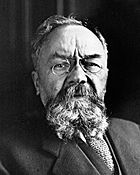
- Avitus (around 385–456), a Roman emperor.
- Fadela Amara (born 1964), a feminist and politician.
- Martine Blanc (born 1944), an author and illustrator of children's books.
- Nicolas Chamfort (1741–1794), a writer known for short, clever sayings.
- Cécile Coulon (born 1990), a novelist, poet, and short story writer.
- Gregory of Tours (around 538–594), a historian and bishop.
- Annelise Hesme (born 1976), an actress who also plays cello and piano.
- André Michelin (1853–1931) and Édouard Michelin (1859–1940), who started the Michelin tire company.
- George Onslow (1784–1853), a composer, mostly of chamber music.
- Paloma (born 1991), a drag queen who won the first season of Drag Race France.
- Blaise Pascal (1623–1662), a famous mathematician, physicist, and philosopher.
- Jacqueline Pascal (1625–1661), a child genius and younger sister of Blaise Pascal.
- Audrey Tautou (born 1976), a well-known actress and model.
Sports Stars

- Chakir Ansari (born 1991), a Moroccan freestyle wrestler who competed in the 2016 Summer Olympics.
- Laure Boulleau (born 1986), a footballer who played for the French women's national team.
- Patrick Depailler (1944–1980), a Formula One race car driver.
- Yves Dreyfus (1931–2021), an epee fencer who won a bronze medal at the 1956 Summer Olympics.
- Gabriella Papadakis (born 1995), an ice dancer who is an Olympic, World, and European champion.
- Aurélien Rougerie (born 1980), a rugby union player who played for the French national team.
- Christian Sarron (born 1955), a Grand Prix motorcycle racer.
- Remi Cavagna (born 1995), a professional road cyclist.
People Who Lived in Clermont-Ferrand
- Sidonius Apollinaris (around 430–after 489), a poet, diplomat, and bishop.
- Henri Bergson (1859–1941), a philosopher.
- Olivier Bianchi (born 1970), the current Mayor of Clermont-Ferrand.
- Valéry Giscard d'Estaing (1927–2020), who was the president of France from 1974 to 1981.
- Claude Lanzmann (1925–2018), a filmmaker who attended school here.
Education in Clermont-Ferrand
Education is a very important part of Clermont-Ferrand's economy.
The University of Clermont Auvergne was formed in 2017. It has over 37,000 students and many teachers and staff.
SIGMA Clermont is the largest engineering school in the city, with about 1,000 students.
The ESC Clermont Business School, started in 1919, is also located here.
Twin Towns – Sister Cities
Clermont-Ferrand has special partnerships with other cities around the world. These are called twin towns or sister cities:
 Aberdeen, Scotland, United Kingdom (since 1983)
Aberdeen, Scotland, United Kingdom (since 1983) Braga, Portugal
Braga, Portugal Gomel, Belarus
Gomel, Belarus Norman, Oklahoma, United States
Norman, Oklahoma, United States Oviedo, Spain
Oviedo, Spain Regensburg, Germany (since 1969)
Regensburg, Germany (since 1969) Salford, England, United Kingdom
Salford, England, United Kingdom
See also
 In Spanish: Clermont-Ferrand para niños
In Spanish: Clermont-Ferrand para niños
- Communes of the Puy-de-Dôme department
- Jaude Centre
- List of works by Auguste Carli
- List of twin towns and sister cities in France
- Trémonteix sanctuary





